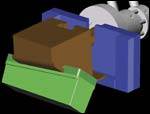How to Choose the Correct Ejector Pin?
The importance of working temperature during the ejector pin selection process.
There are many different kinds of ejector pins in the market nowadays and it is a challenge for users to select the correct ones. In most cases, selecting an inappropriate ejector pin is wasting resources and creates inefficiency in production.
Many of us understand the importance of material and related hardness when selecting an ejector pin. However, in this article, we will focus on another important factor and that will be the working temperature.
Working Temperature
Working temperature is crucial because it affects the lifetime or durability of an ejector pin. For example, if the working temperature is high and the ejector pin being used is made for a low working temperature environment, then the ejector pins will certainly not last long.
In the market, there are three common types of ejector pins: (1) through hard pins, (2) nitride H13 pins and (3) the newly developed black ejector pins. All of these pins are excellent to use; however, each has its own characteristics and is designed to be used in a specific environment.
Through Hard Pins
The design of the through hard pins involves the same hardness throughout the diameter of the ejector pin. With this characteristic, the ejector pin can last much longer in working temperatures below 200oC. It is mainly suitable for plastic injection molds.
Nitride H13 Pins
If the working temperature goes beyond 200oC, then nitride H13 pins will be a much better fit. The reason is that the surface of these pin has a hardness of HRC 65 to 70, which can lead to a much better life expectancy in high working temperatures. These pins are best for die casting.
Black Ejector Pins
Nitride H13 pins are not suitable for working temperatures that exceed 600oC, so black ejector pins were developed as an option. These pins have a special black surface coating treatment on the entire pin that can sustain working temperatures up to 1,000oC. Also, the special black surface treatment provides additional self lubrication to the ejector pin, making it an excellent fit for automobile injection molding. These pins are suitable for most working temperatures, but the cost of such a pin is higher.
Summary
From the above comparison, it is evident that different types of ejector pins are suitable for different environments, which is why working temperature is a necessary factor to consider before your final selection. This will also apply to ejector sleeve and ejector blade selection.
Related Content
-
Revisiting Some Hot Runner Fundamentals
What exactly does a hot runner do? If you’ve been in the injection molding industry for any length of time, you might think the answer is obvious, but it is not.
-
Hands-on Workshop Teaches Mold Maintenance Process
Intensive workshop teaches the process of mold maintenance to help put an end to the firefighting culture of many toolrooms.
-
Making Quick and Easy Kaizen Work for Your Shop
Within each person is unlimited creative potential to improve shop operations.
















